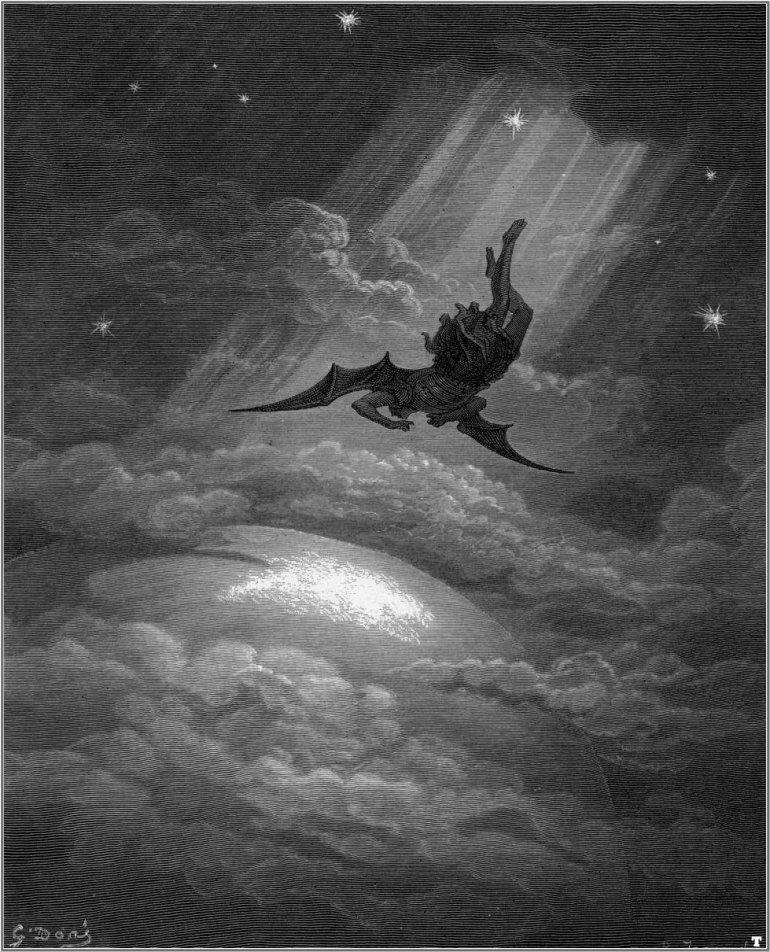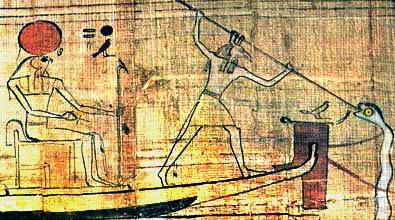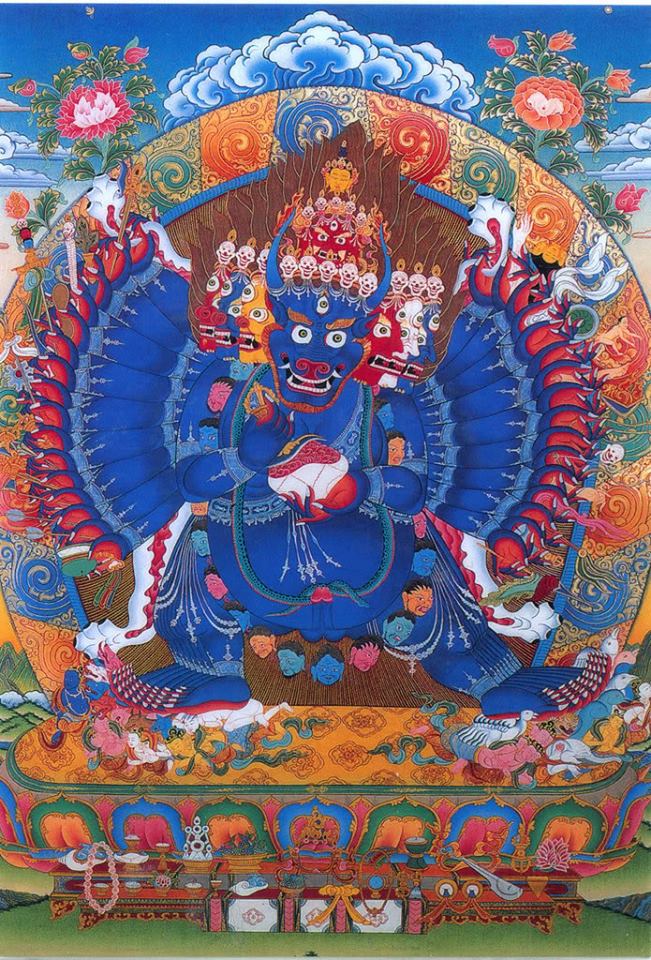In the Satanic narrative, I find that Dante serves as a syncretic milestone for fusing the Greco-Roman, Jewish, and Christian afterlives together (the latter being a syncretization of Persian and Egyptian influences). The next syncretic milestone can be found in John Milton’s epic poem, Paradise Lost. This was written in the 1600s, so about 300 years after Dante, in English, and after the Grimoires started being written.

Dore’s depiction of Lucifer in Paradise Lost
The most interesting detail added by Milton is Pandæmonium. Pandæmonium is the capital city of Hell; but for the modern magickian we can see already how this is interesting. We could consider Pandæmonium the collection of all demons (literally what “Pandæmonium” translates to). The inventive magickian can go out and just skip over the hair-splitting rituals of the Ars Goetia and instead directly invoke Pandæmonium.
I feel that Dante dampened the Satan figure in Inferno, relegating him to the pit boss of a daycare for infidels, and removed the adversarial component from the picture. Satan is just this really bad guy who punishes bad people and unbelievers. He lacks the turn away from the good and from divinity which I argue makes Satan interesting in the first place.
Satan, in accordance with the adversarial archetype, is against:
Religion — the control and limiting of the ordinary person’s every day actions as well as their ability to experience the divine. It is not a historical irony that Gnosticism (the direct experience of the divine) almost always subverts the order of the deities and elevates Satan to a good entity and the creator god becomes subverted into the deceiving warden of a world of illusion.
Transcendentalism — Satan is a materialist god, being a god of the earth.
Morality — Satan says fuck, fight, feast as you please
Convention — Satan says fuck who you want, fight who you want, eat what you want
Monotheism — Satan either admits of equal divine status to the “main” god of a mainstream religion, or is one god in the company of gods (Pagan Satanism)
Order — in Zoroastrianism, the concept of “Asha” meant Order, and its opposite, “Droog” signified Chaos. The gods of Asha and Droog were Ahura Mazda and Angra Manyu respectively. The “good” followers, who embraced Asha, feared and fought these hypothetical agents of chaos and conflict.
Almost every book I have read on Satanism basically repeats those core concepts but does so in 10 times as many words.
But as you will soon understand, the adversarial archetype is only a component of what makes Satan the entity it is. The core premise of the adversarial archetype is that
a) an entity “A” exists, and
b) another entity “B” also exists in strict opposition to “A”
We can do a lot more with this than is portrayed in the Judeo-Christian-Islamic paradigms.
As you can see, we have transitioned from the Judaic “SHaiTaN” as the sole representative of the adversarial algorithm, to include the Zoroastrian Angra Manyu. Fittingly, the list of adversarial entities will soon expand beyond our control. That is because this is a concept that avoids all attempts to compartmentalize and syncretize gods back into submission. Any time we attempt to say “This god is like that god,” Satan will throw a wrench into the machinework and say, no, I have more to come at you.
In this sense, Satanism is more intuitive and naturalistic than anything human kind has invented (Satanism in this case being a ‘discovery’ about the merciless and uncaring Earth we inhabit, or some moralizing tale about the human psyche).
As you can see, however, in Judaism, Christianity, and Islam, which share a single god who also wants all three of his people to fight each other, there is a notion of an outsider who is evil. He is fought against. But the title of Satan is not the name of a specific entity, as a handful of other antagonists show up in scripture. One that is commonly equivocated with Satan is the snake in the Garden of Eden. Its name is Nachash — and isn’t actually Satan. At all. The snake is a symbol of initiation; and the Hebrew Gematria value for Nachash is the same as the value for Messiah.
In Zoroastrianism, there are two competing gods. and the followers of this religion rally under the banner of the good Ahura Mazda. However, and in distinction from Judaism, Christianity, and Islam, Angra Manyu is an integral part of the dualistic Zoroastrian universe, whereas Satan is an enemy that was conquered, delegated to the fiery pits where damned souls eternally burn, and who will be perpetually beaten into submission.
Both of these modalities are in sharp distinction to Ancient Egyptian religion, which features two salient (among admittedly many others) adversarial entities: Apep and Set. So in this case, we will observe a god that was favored by some but then pushed aside and no longer worshipped — yet was actually an adversary *of* another adversary; and we see a god that was part of a dualistic complex and worshipped *against*. It may help to view Asha and Droog as diametrically opposed forces, whereas Satan and El fit into a hierarchy.
Set was a god of the desert (the outskirts of Egypt). Osiris became more prevalent and was the giver of life, associated with the Nile (the cities along which became more prominent as the Egyptian Empire rose and consolidated power over a unified Egypt). In most formulations of Egyptian mythology, Set kills or helps kill Osiris, who in turn becomes the Egyptian afterlife (Pharaohs become Osiris upon death) and comes back to life on Earth as his son, Horus.
Apep was a snake that ate the sun at Night (First mentioned in Seventh and Eighth Dynasties 2181–2160, and eventually honoured by the time of the 14th Dynasty). Also called the God of Chaos, Apep was the adversary of Ra, dwelled beneath the horizon in Duat (the underworld), and fought Ra (who was in turn assisted by Set). Apep was the setting of the sun, and was worshipped against at night so as to bring Ra back in the morning as the rising sun. Effigies to Apep were regularly burned in order to banish Chaos.
As Ra emerged in the Fifth Dynasty, but later merged with the god Horus, as Ra-Horakhty/Ra-Hoor-Khuit (“Ra, who is Horus of the Two Horizons”), we have ample evidence that Apep (the later addition) was an embellishment that marks the evolution of the Egyptian religion. Or, perhaps, Ra, Osiris, Set, and Apep all had distinct roles as political egregores pertaining to different factions of society that gained and lost control of the Egyptian empire over the expanses of time. So in this paradigm, even the adversary can be against another adversarial entity.
 Set defending Ra-Hoor-Khuit against Apep
Set defending Ra-Hoor-Khuit against Apep
If we venture to India and Tibet, the birthplaces of Hinduism (a collection of religious and philosophical schools) and Buddhism (a set of practices meant for achieving direct religious experience), we find no such thing as Heaven and Hell. Nor are Nirvana and Samsara really analogous in the way we can say “Angra Manyu is almost the same as Satan.” But we can find things that bear piece-wise resemblance: there are realms where demons dwell and where the dead go temporarily, such as Naraka, where Yama presides. But in some forms of both Hinduism and Buddhism, these are states of mind, or places on earth. If we go further east, we can find Yomi, the “the shadowy land of the dead” in Shintoism, and we can read about Izanagi-no-Mikoto, who travelled there to be reunited with his dead wife. This bears a vague similarity to the Greek story of Orpheus and Eurydice. Yomi is decoupled from any adversarial figure.
But Buddhism has adversarial figures without an underworld per se. Mara, who bears the most similarities to Choronzon out of any figure we have and will explore, systemically tempts and deceives those on the path to attainment. Usually this is coupled with lustful imagery. Choronzon, dwelling in Da’ath tempts the aspirant passing through the abyss with visions of false attainment and promises of hedonistic gratification that will inevitably turn out to be empty. Da’ath means “Knowledge” but also “Having known in a sexual way” — so in a way, if Choronzon gets you, he will crawl inside your mind and fuck your sanity to death. Choronzon was first made known to the world in the writings of John Dee, and was encountered by Aleister Crowley in his scrying of the 10th Aethyr.
A high-ranking Ordo Templi Orientis officer told me that “Choronzon is the devil in Thelema.” But a high-ranking Temple of Thelema officer told me that “Choronzon is not the devil.” Perhaps this says something of the nature of Choronzon.
In both Mara and Choronzon, the adversarial component stands against the individual consciousness, not the transcendental or divine.
The active counterpart to Mara is Yama, or the god of death.
 A Tibetan depiction of Yamantaka
A Tibetan depiction of Yamantaka
Here is where it gets interesting. Yama, or death, has its own death: Yamantaka, one of the Eight Wrathful Kings of esoteric Buddhism.
“A holy man was told that if he meditated for the next 50 years, he would achieve enlightenment.
The holy man meditated in a cave for 49 years, 11 months and 29 days, until he was interrupted by two thieves who broke in with a stolen bull.
After beheading the bull in front of the hermit, they ignored his requests to be spared for but a few minutes, and beheaded him as well.
In his near-enlightened fury, this holy man became Yama, the god of Death, took the bull’s head for his own, and killed the two thieves, drinking their blood from cups made of their skulls.
Still enraged, Yama decided to kill everyone in Tibet.
The people of Tibet, fearing for their lives, prayed to the bodhisattva Manjusri, who took up their cause. He transformed himself into Yamantaka, similar to Yama but ten times more powerful and horrific.
In their battle, everywhere Yama turned, he found infinite versions of himself. Manjusri as Yamantaka defeated Yama, and turned him into a protector of Buddhism.”
